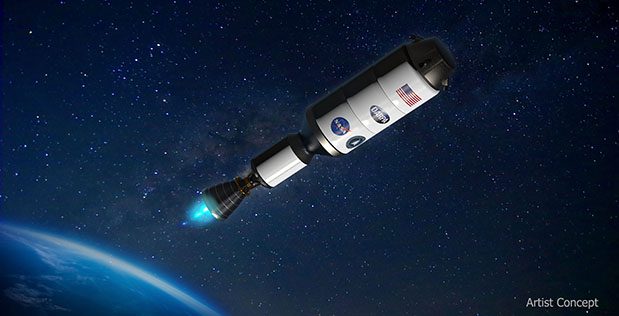While Nuclear Thermal Propulsion (NTR) concepts (e.g. the NERVA project) have been considered for space missions since the 1960s, their lack of suitable application combined with their technical risk has held back their actual use – until now. Seeing that a human Mars and certain lunar missions may need this technology – cryogenic chemical propulsion has only a limited specific impulse (the measure of how much “push” you get per kilo of propellant) – NASA and the military DARPA agency have come together to sponsor a actual NTP demonstration. Essentially NTP technology works by increasing the specific impulse by using a nuclear reactor to provide an extra heat source for the propellants – usually hydrogen. The technology could theoretically dramatically cut the circa nine month travel time between Earth and Mars reducing the crew’s long term exposure to radiation, while also cutting down on the need for taking up heavy consumables such as food.

Artist’s impression of DRACO nuclear thermal spacecraft. Courtesy: DARPA
The DRACO (Demonstration Rocket for Agile Cislunar Operations) mission was originally announced in January. However, it is only now that the contacts have been formally awarded. NASA and DARPA have formally awarded Lockheed Martin a contract to build a demonstration spacecraft using a NTP engine. The engine’s reactor and fuel – the engine will use High Assay Low Enriched Uranium (HALEU) fuel to rapidly heat a super-cold liquid hydrogen whose high velocity gas is then exhausted through a rocket nozzle – will be provided by BMX Technologies. The total cost of the contracts is US$499 million shared between NASA and DARPA. The demonstration flight – officially called Experimental Nuclear Thermal Reactor Vehicle (X-NTRV) will take place no later than 2027, with late 2026 being seen as the likely date.
The spacecraft itself will be launched by a conventional rocket system and will only be used away from Earth, albeit that some engine testing on Earth will be required. .







